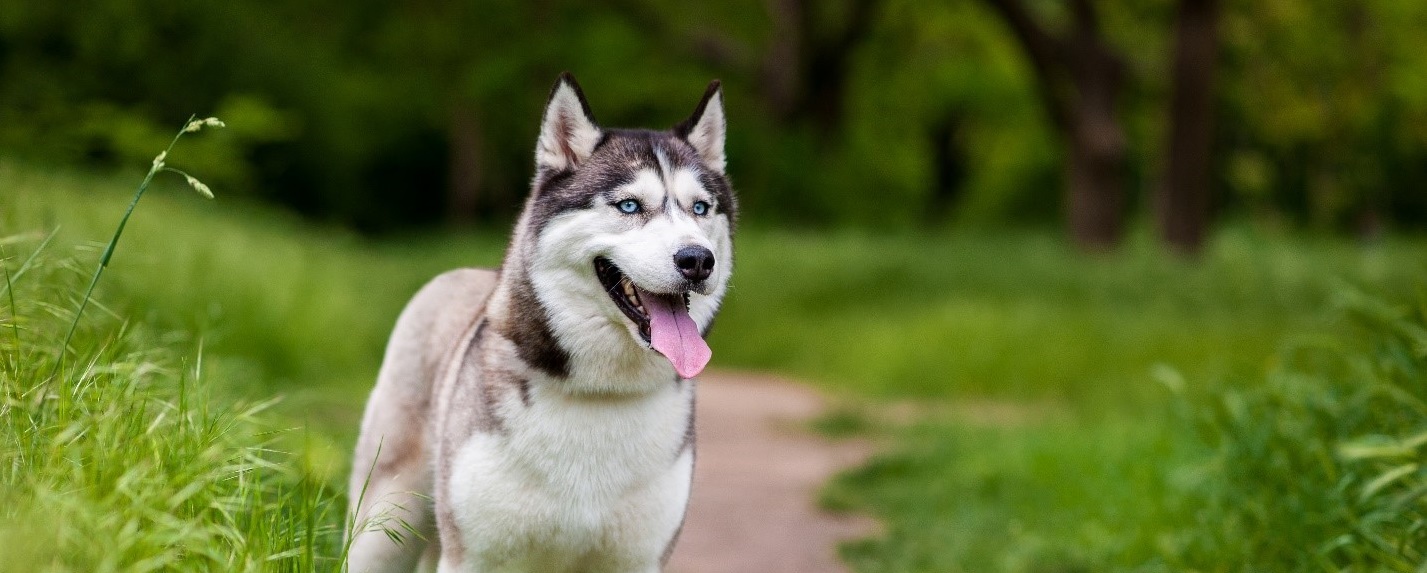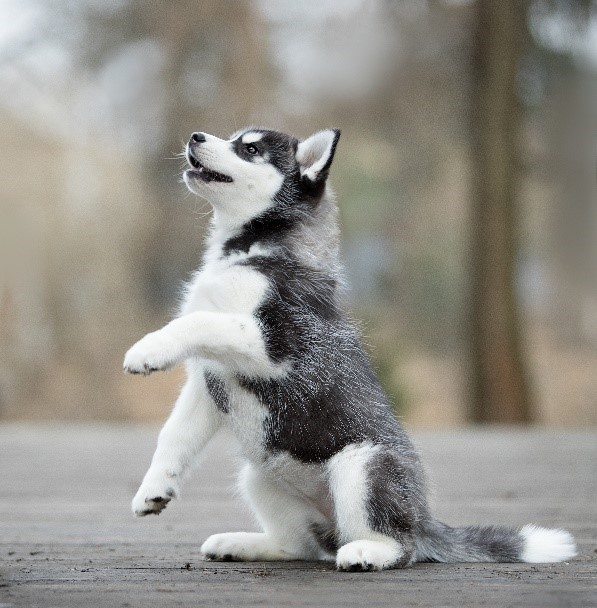
Husky
Posted: 02/14/2023 | BY: Content Writer
Husky Dog Breed Profile
Pet Profile
- Large (50cm to 60cm)
- Typically weighing between 16kg and 27kg
- 12 to 15 years life expectancy
“Husky” is an umbrella term used for lots of different types of sled dogs, but mostly refers to the Siberian Husky and the Alaskan Husky.
Bred as working dogs, they are high-energy, intelligent breeds that thrive off having a job to do and a pack to rely on.
Originating from colder climates, these arctic breeds have adapted to withstand the cold and have traditionally been used by people to pull heavy loads across the snow; they are often used for racing and tourism in modern times.
Loyal, affectionate, and friendly, huskies like to live in packs and will view their owner as the leader of the pack.
Don’t make the mistake of thinking this means they’re obedient however, these dogs have a mind of their own and will continually push boundaries, even with the alpha of the pack (you!).
This, as well as their tendency to get destructive when bored, has earned them a bit of a reputation as being naughty.
Inexperienced owners and those unprepared for a high maintenance pet often underestimate the work involved with looking after a husky, and as a result, many of these beautiful animals end up handed into adoption centers.
Highly intelligent and social, huskies require lots of stimulation and attention and can suffer from separation anxiety if left alone too often.
They love people and are generally friendly towards everyone, even strangers, so they’re not cut out to be guard dogs. While huskies are often great with children, they have a very high prey drive and will chase smaller animals such as cats and rodents.

History of Husky Dogs
The Siberian Husky was first bred in northeast Asia by the Chukchi people as companion dogs and sled dogs.
In the early 1900s, they grew in popularity for sled races. In 1925, a dog sled team delivered a life-saving serum to the isolated town of Nome, Alaska when an epidemic of diphtheria broke out.
A husky sled team led by the infamous lead dog Balto ran 658 miles in only 5 days delivering medicine that stopped the epidemic. Balto is a recognized dog today, featured in a Disney movie and even has a statue in New York’s Central Park.
Today, mushers still use huskies as sled dogs for fun and sport. They have become a popular dog breed for their sociable and silly personalities.
Characteristics of Husky Dogs
There are two main husky breeds that are often just called huskies interchangeably: the Siberian Husky and the Alaskan Husky.
Siberian Husky
The Siberian Husky is recognized by the American Kennel Club as a pure breed and is generally the best-known of the husky breeds.
Thought to originate from Eastern Siberia, these dogs were bred by the Chukchi people, hunter-gathers in the harsh Siberian Arctic who valued the hard-working characteristics and thick double coats of the husky for the tough conditions they worked in.
Modern Siberian Huskies are bred for their beautiful appearance as well as their behavior, and a variety of colors, patterns, and markings are common.
The black and white husky with sharp blue eyes is one of the more desired appearances.
Alaskan Husky
Unlike the Siberian, the Alaskan Husky is a mixed breed that was bred purely for its working capabilities and not looks. This breed is mostly from in Alaska, hence its name.
Although not technically a recognized breed, they have still been selectively bred to be intelligent, active, and hard-working.
You can usually tell the difference between an Alaskan and a Siberian Husky as an Alaskan will have a thinner coat, looks slimmer, and is slightly less tolerant of the cold. They are also more likely to be brown-eyed than blue.
Adopting A Husky Dog From A Breeder Or Rescue
When you adopt a husky puppy, it is recommended to adopt from a breeder registered with the Siberian Husky Club, American Kennel Club, or other national breed clubs to ensure they are a reputable breeder.
Huskies can often be found in shelters or husky rescues because they are a sought-after breed that can be hard for many pet owners to handle, which is why proper training, lots of mental stimulation, and exercise are so important for adopters to be aware of.
Exercise And Nutrition of Husky Dogs
Huskies are very active and energetic dogs so you will need to give them at least 2 hours of exercise every day. Without proper exercise, your dog may become destructive and tear up your home and garden.
Huskies have a very high prey drive and will run off if they spot something to chase. Many owners prefer to keep them on an extendable lead at all times for this reason.
Huskies aren’t known for being very obedient, but they are highly intelligent and enjoy the positive reinforcement of training sessions.
You will need to train them from a very young age before they become too stubborn and set in their ways, and you will need to continue to demonstrate that you are leader of the pack to keep them obedient.
Huskies aren’t generally prone to overeating and tend to moderate their food depending on how active they’ve been.
You should opt for high-quality, protein-based foods and avoid cereal/wheat-based dog foods which huskies can have trouble digesting.
Keep an eye on your dog’s weight and adjust portions if they become under or overweight. Huskies are stubborn and easily bored so try adding variety to their meals if they go off their food.
Common Health Problems And Illnesses Of Husky Dogs
Huskies are overall known as relatively a healthy breed. They should be examined as juveniles for health problems such as cataracts to address and care for early on.
It is recommended to take out pet insurance on your husky dog as a puppy to ensure the best care throughout their life.
Eye Defects
One of the key health concerns for huskies is their eyes. Progressive retinal atrophy, cataracts (both juvenile and hereditary), and corneal dystrophy are some of the most common eye defects found in huskies and can be very serious, even leading to blindness in worst-case scenarios.
Responsible owners should always ask for the parent’s health records to check for any hereditary conditions in their puppy.
Hip Dysplasia is not as common in huskies as in other large dog breeds, but it is still a concern. The condition refers to an abnormality in the hip joint which prevents the femur from fitting into the socket properly and can cause severe pain. As with eye defects, you should check the health records of your dog’s parents for hip dysplasia.
This condition is often found in larger dog breeds and refers to a problem with the body’s ability to make enough thyroid hormone. You may notice problems with your dog’s skin and coat or possibly some behavioral problems. Your vet will generally carry out regular tests for this disease and may prescribe hormone replacements to address the problem.
Idiopathic epilepsy is often inherited and is common in Siberian Huskies. Seizures usually begin at a young age and your vet will likely prescribe lifelong medication and regular check-ups to monitor your dog’s well-being.
Huskies seem to be more prone to a deficiency in zinc, which is important for your dog’s immune system and their hair, skin and nails. Lack of zinc can lead to a range of problems, including skin infections, foot problems, poor growth and more.
You should always get any worrying symptoms checked by a vet and wait for a diagnosis before upping your dog’s zinc-intake, as too much zinc can be just as bad for your dog’s health.
Fun Facts About Husky Dogs
- The TV series Game of Thrones is thought to have caused a spike in the number of people wanting to take home a husky because of their resemblance to the show’s direwolves. Unfortunately, huskies can be very high maintenance and so many of them end up in animal shelters because their owners underestimate the work involved with owning one.
- Several U.S. universities have chosen the husky as their mascot, including the University of Washington, the University of Connecticut, Northern Illinois University, and Michigan Technological University.
- There is a bronze statue of a husky who famously ran the final stretch of the 1925 “Great Race of Mercy” in Central Park, New York. He quickly became the most famous dog of the time after Rin Tin Tin.
- Siberian huskies will curl their thickly furred tails over their faces and noses to keep warm when resting. This is affectionately known as the “Siberian swirl”.
- Husky owners often describe their dogs as being great escape artists as they will dig under gates and have been known to jump over 6ft fences.
